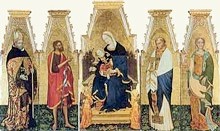This artist, who presumably came from Velletri, Lazio, is known from:
-
✴a signed polyptych (ca. 1421) from Santa Maria Novella (later San Benedetto dei Condotti) that is now in the Galleria Nazionale (see below); and
-
✴a document (1437) that records that Bishop Bartolomeo Aglioni of Todi asked Bartolomeo da Miranda to evaluate an expensive work of art that had been commissioned under his auspices according to the will of Pace di Marco for the high altar of Santa Maria a Montecchio di Baschi.
The style of the painting in the Galleria Nazionale reveals Lello to have been a follower of Gentile da Fabriano.
Perugia
Panels from a Polyptych (early 15th century)

In 1791, Baldassare Orsini recorded the presence of these five panels in Sant’ Agostino. He also reported that:
-
✴two associated predella panels, which depicted the Crucifixion and the martyrdom of St Sebastian, were separately displayed; and that
-
✴the work came from San Benedetto dei Condotti (previously Santa Maria Novella).
The scroll at the foot of the throne in what was the central panel identifies the artist as Lello da Velletri.
It seems reasonable to suppose that the panels came from a polyptych that the hermits from Montemable commissioned for the high altar soon after they moved to Santa Maria Novella in 1421. They probably took the panels to Sant' Agostino in 1641, when Santa Maria Novella was ceded to the Sylvestrines. The main panels entered the Galleria Nazionale in 1863, by which time the predella panels had been lost.
All five panels are set in a flowery meadow, and each has a gold background:
-
✴The central panel depicts the Madonna and Child enthroned with two kneeling angels. The Madonna offers a small bunch of red and white flowers to the Child, signifying the Crucifixion.
-
✴The other panels depict saints whose identities are recorded by inscriptions in the haloes:
-
•St Augustine, whose Rule was followed by the Augustinian hermits;
-
•St John the Baptist, who probably commemorated Fra Battista da Gubbio, the prior who commissioned Santa Maria Novella and whose death possibly preceded the commission of the altarpiece;
-
•St Liberatore, who probably commemorated Fra Liberato di Simone, a monk from the earlier monastery on Montemalbe who was murdered in 1391; and
-
•St Agatha, who holds her severed breasts on a plate.
Todi
Frescoes in Santa Maria in Camuccia (ca. 1437)

-
✴the detached fresco of the Annunciation, which is now on the entrance wall of the chapel was rediscovered in 1968 on the back wall (illustrated here); and
-
✴the frescoes of the Evangelists in the vault, of which only one (St Luke) survives.
The attribution of the Annunciation is made by Todini, referenced below.
Read more:
M. Minardi, “Profili Biografici degli Artisti: Lello da Velletri” in
A. de Marchi, L. Laureati and L. Mochi Onori (Eds), “Gentile da Fabriano: Studi e Ricerche”, (2006) Milan p 173
F. Todini, “Lello da Velletri e il Vero Bartolomeo da Miranda”, Studi di Storia dell’ Arte, 2 (1991) pp. 51-84.



